Unlocking Blockchain Secrets: Top Onchain Analysis Tools for 2025
Introduction
Onchain analysis is an essential part of understanding cryptocurrency. It provides valuable information about blockchain data like transactions, trades, and wallet holdings. This data can be used by crypto investors and traders to make better decisions in the unpredictable world of crypto.
How Onchain Analysis Works
Blockchain technology is the foundation of onchain analysis. It creates a public record of all transactions that have ever occurred on a particular blockchain network. This record is known as the blockchain ledger and is stored across multiple computers, making it nearly impossible to alter or delete any transaction information.
By analyzing this transparent and secure ledger, onchain analysis tools can gather a wealth of data directly from the blockchain. This data includes details about individual transactions, such as the sender, receiver, and amount transferred. It also includes information about wallet addresses and their associated balances.
The Power of Onchain Analysis
The true value of onchain analysis lies in its ability to turn raw blockchain data into actionable insights. Here are some ways in which it can be used:
- Understanding Market Trends: By studying historical transaction data, investors can identify patterns and trends in buying or selling behavior. This can help them anticipate market movements and make more informed investment decisions.
- Tracking Institutional Activity: Onchain analysis tools can detect large transactions that are likely made by institutional investors or whales. Monitoring these activities can provide insights into market manipulation or significant shifts in investor sentiment.
- Assessing Token Distribution: Onchain analysis allows for the examination of token distribution across different wallets. This information is crucial for understanding whether a particular cryptocurrency is concentrated in the hands of a few individuals or widely held by many.
- Analyzing Trading Strategies: Traders can use real-time onchain data to evaluate their trading strategies and make adjustments accordingly. For example, they may look for signs of increased buying pressure before entering a long position or monitor for large sell orders indicating a potential price drop.
By leveraging these data-driven strategies, both investors and traders can enhance their decision-making processes and potentially improve their returns in the volatile crypto market.
Keywords: onchain analysis, blockchain, cryptocurrency, crypto investors, traders
1. Glassnode
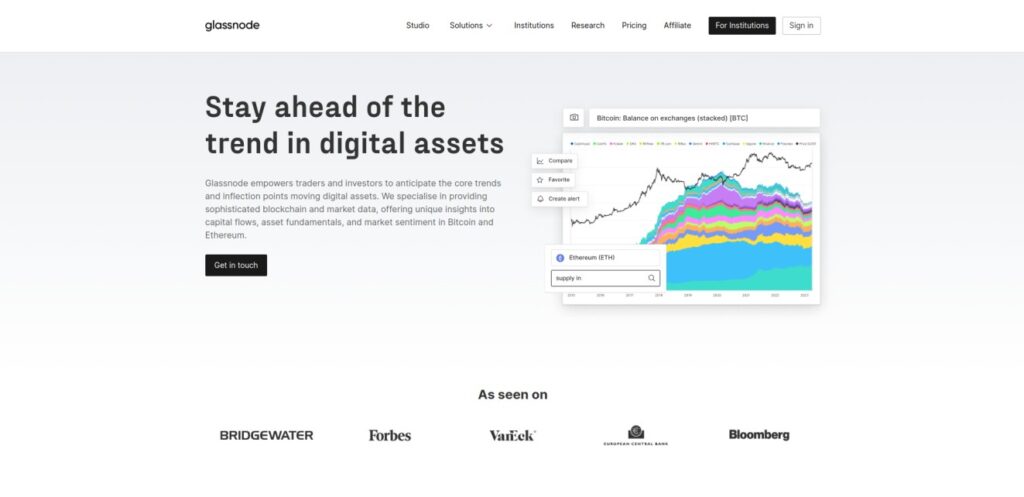
Glassnode is a leading onchain analysis tool in the cryptocurrency world, providing in-depth information about blockchain data. Known for its accuracy and extensive dataset, Glassnode helps investors and traders make informed decisions.
Key Features and Functionalities
Glassnode offers a wide range of features:
- Market Sentiment Analysis: Understands the broader market mood by analyzing various metrics like active addresses, transaction volumes, and exchange flows.
- Ownership Patterns: Tracks the distribution of crypto holdings across different wallet sizes. This helps in identifying whale movements and potential market manipulations.
- Price Action Tools: Offers tools such as SOPR (Spent Output Profit Ratio) and MVRV (Market Value to Realized Value) ratios to gauge price trends and market cycles.
Utilizing Glassnode for Onchain Analysis
To make the most of Glassnode's capabilities:
- Analyzing Market Sentiment: Use metrics like NVT (Network Value to Transactions) ratio to determine whether a cryptocurrency is overvalued or undervalued relative to its transaction volume.
- Tracking Ownership Patterns: Monitor large wallet addresses to detect significant shifts in holdings that might indicate upcoming price movements.
- Utilizing Price Action Tools: Employ SOPR and MVRV ratios to identify profit-taking levels and potential reversal points in the market.
Pros and Cons of Glassnode
Pros:
- Comprehensive Data Coverage: Access to extensive blockchain data across multiple cryptocurrencies.
- User-Friendly Interface: Intuitive dashboards that simplify complex data visualization.
- Real-Time Updates: Timely updates ensure users have the latest information.
Cons:
- Premium Pricing Model: Advanced features require a subscription, which may be costly for some users.
- Learning Curve: The complexity of the platform might be daunting for beginners.
Glassnode remains a vital tool for anyone serious about onchain analysis, offering unparalleled insights into market dynamics and ownership patterns.
Unlock Your Free Glassnode Trial Today
2. Nansen
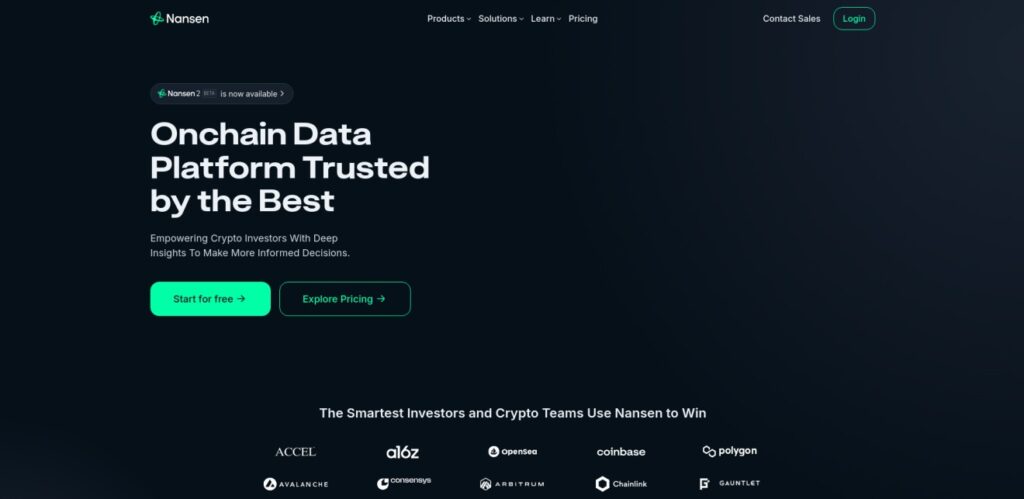
Nansen is a comprehensive onchain analytics platform that focuses on the Ethereum and other evm based blockchains. It is designed to provide detailed information about blockchain data, making it useful for both crypto investors and traders who want to understand the market better.
Key Features and Functionalities
Here are some of the main features of Nansen:
- Smart Money Dashboard: Identifies influential wallets and tracks their asset movements.
- Token God Mode: Offers detailed analysis of specific tokens, including holder distribution and transaction history.
- Smart Alerts: Customizable notifications for significant onchain activities.
- NFT Analytics: Provides in-depth data on NFT transactions, ownership patterns, and market trends.
DeFi Capital Markets and NFT Analytics
Nansen is especially good at analyzing DeFi capital markets through tools that look at liquidity pools, lending protocols, and yield farming activities. The platform's specialized tools offer:
- Liquidity Pool Analysis: Tracks inflows and outflows in leading DeFi protocols.
- Yield Farming Insights: Monitors returns from various yield farming strategies.
- NFT Market Trends: Analyzes transaction volumes, price movements, and ownership changes in the NFT space.
Pros and Cons of Using Nansen
Here are some advantages and disadvantages of using Nansen:
Pros:
- Comprehensive Data Coverage: Extensive metrics for Ethereum-based assets.
- User-Friendly Interface: Intuitive dashboards tailored for both novice and experienced users.
- Real-Time Analysis: Quick access to up-to-date blockchain data.
Cons:
- Cost: Premium features may be expensive for small-scale investors.
- Ethereum Focus: Limited support for blockchains other than Ethereum.
Nansen's strong features make it a powerful tool for those invested in the Ethereum ecosystem, offering unparalleled insights into both DeFi capital markets and the growing world of NFTs.
Explore Nansen with a Free Trial
3. Messari
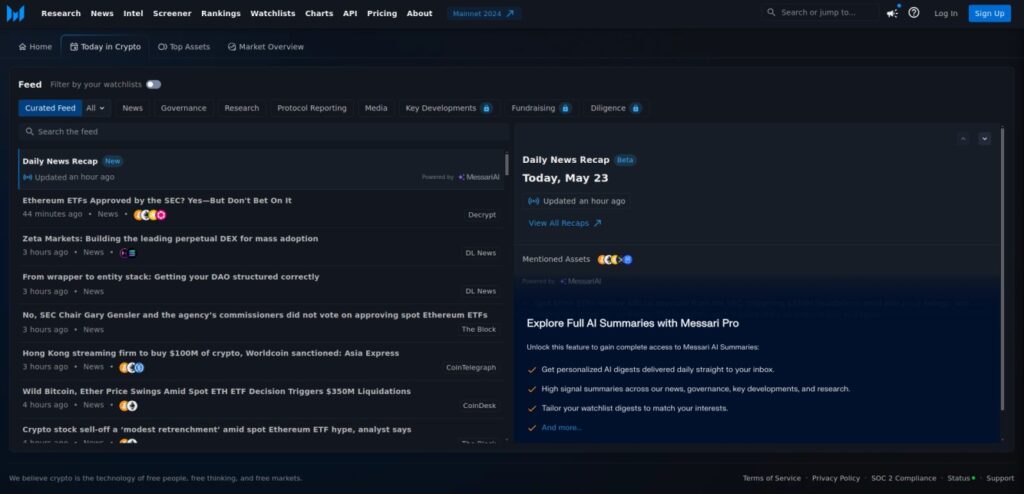
Messari is a versatile onchain analysis tool designed for comprehensive crypto market analysis. It is known for its robust data aggregation and analytical capabilities, providing investors and traders with in-depth insights into various blockchain networks.
Key Features and Functionalities of Messari
Messari offers a suite of features tailored to the needs of both novice and experienced crypto enthusiasts:
1. Real-time Market Data
- Access to real-time prices, volumes, and market cap data across multiple cryptocurrencies.
2. Research Reports
- In-depth research reports on emerging trends, technological developments, and market insights.
3. Charting Tools
- Advanced charting tools for visualizing market trends and historical data.
4. Custom Alerts
- Set up custom alerts for price movements, trading volumes, and other critical metrics.
Pros and Cons of Messari for Onchain Analysis
Pros:
- Comprehensive Data Coverage: Wide-ranging data coverage across multiple blockchain networks.
- User-friendly Interface: Intuitive interface that simplifies complex data visualization.
- Detailed Research Insights: High-quality research reports that provide actionable insights.
Cons:
- Subscription Costs: Premium features require a subscription, which may be costly for some users.
- Data Overload: The extensive range of data can be overwhelming for beginners.
Messari's blend of real-time data, detailed research reports, and user-friendly tools make it an essential platform for those looking to gain a deeper understanding of the crypto market.
4. Dune
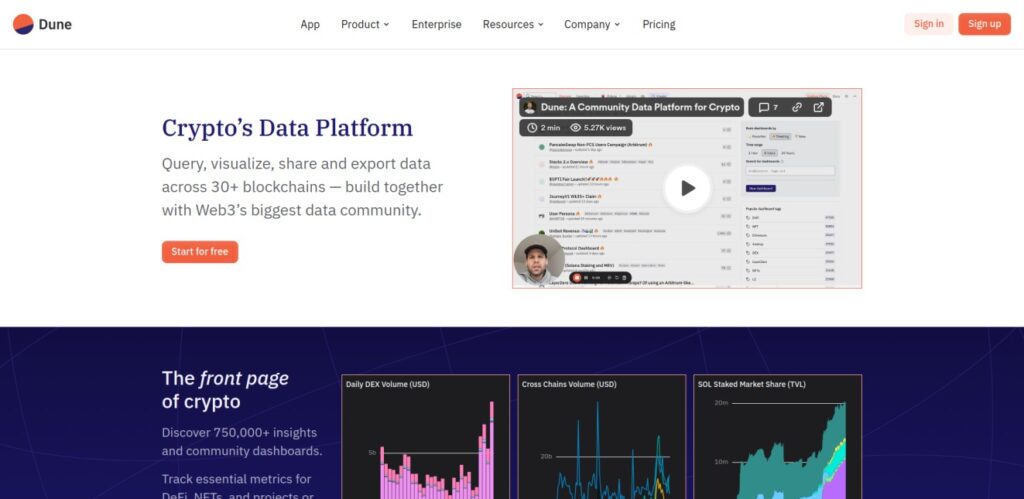
Dune is the largest community-run web3 onchain analysis tool. It aids crypto traders and investors in making informed decisions by offering valuable insights extracted from blockchain data.
Key Features and Functionalities of Dune
- Custom SQL Queries: Users can create their own queries using SQL to extract specific data from the blockchain.
- Interactive Dashboards: Visualize complex data through user-friendly dashboards, promoting deeper understanding and better decision-making.
- Community-driven Insights: Benefit from a vibrant community where users share publicly available dashboards and datasets, fostering collaborative analysis.
Analyzing Market Trends Through Active Addresses on Dune
One of the significant strengths of Dune is its ability to analyze market trends via active addresses. By monitoring the number of active addresses over time, users can gauge market activity, interest levels in specific tokens, and potential growth or decline in user engagement. For instance:
- Spikes in Active Addresses: Indicate increased interest or usage of a particular token or blockchain application.
- Declines in Activity: May signal waning interest or potential issues within the ecosystem.
Pros and Cons of Dune for Onchain Analysis
Pros:
- Flexibility: Custom SQL queries offer unparalleled flexibility in data extraction.
- Collaborative Environment: Community-shared dashboards accelerate learning and analysis.
- Comprehensive Visualization: Interactive dashboards make complex data digestible.
Cons:
- Steeper Learning Curve: Requires familiarity with SQL for advanced querying.
- Data Overload: Beginners may find the vast amount of data overwhelming without proper guidance.
Dune’s capabilities extend beyond mere transaction volume and supply distribution, offering a comprehensive toolkit for those looking to dive deep into blockchain analytics. It provides essential metrics for DeFi, NFTs, and various projects and tokens.
5. CryptoQuant
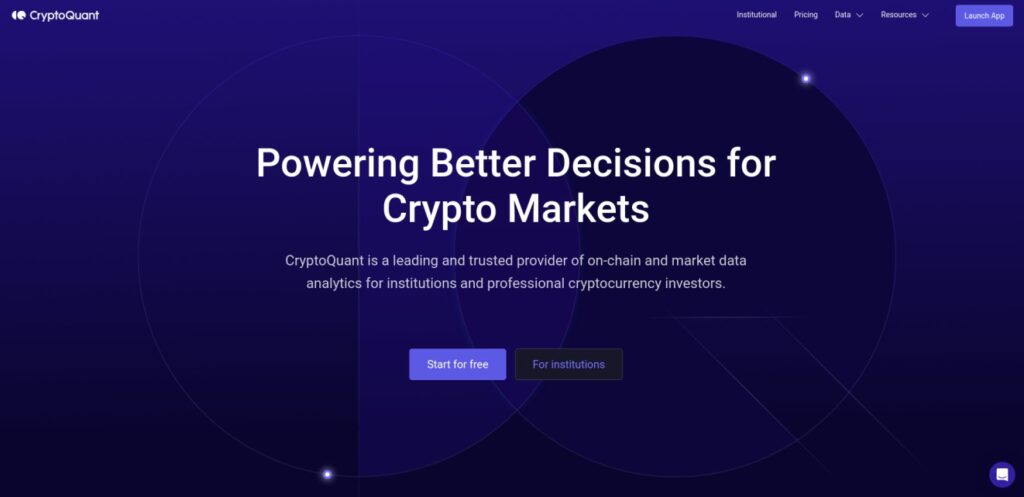
CryptoQuant is a top onchain analysis platform that specializes in understanding the complexities of profits and losses in the cryptocurrency market. It offers advanced analytics specifically designed for traders who want to make smart choices.
Key Features and Functionalities
CryptoQuant has a wide range of powerful tools that can help you analyze blockchain data:
- Realized Profits and Losses Metrics: Keep track of gains and losses from your cryptocurrency transactions. This can give you valuable insights into how the market is feeling and how investors are behaving.
- Exchange Flows: Monitor the amount of cryptocurrency flowing in and out of different exchanges. This information can help you predict potential price movements.
- Network Data: Analyze important metrics like hash rates, difficulty adjustments, and miner flows. By understanding these factors, you can get a better idea of how healthy a cryptocurrency network is.
Stock-to-Flow Ratio
One key concept that CryptoQuant focuses on is the stock-to-flow ratio. This metric measures how scarce an asset is by comparing its current stock (total supply) with its flow (annual production). In onchain analysis, understanding the stock-to-flow ratio can help you predict future price movements based on supply scarcity:
“The higher the stock-to-flow ratio, the greater the scarcity, potentially driving up value.”
Using CryptoQuant’s data, analysts can interpret these ratios to forecast long-term trends in assets like Bitcoin.
Pros and Cons of CryptoQuant for Onchain Analysis
Pros:
- Comprehensive Data Coverage: Extensive metrics covering various aspects of blockchain activity.
- Real-Time Analytics: Instant access to fresh data for timely decision-making.
- User-Friendly Interface: Easy navigation with intuitive visualizations.
Cons:
- Subscription Costs: Advanced features require a paid subscription.
- Learning Curve: Complexity of tools may require time to master for new users.
CryptoQuant remains an indispensable tool for those seeking a deep dive into blockchain-based profit and loss metrics, significantly aiding strategic investment decisions.
6. Santiment

Santiment is a valuable tool for analyzing blockchain data, focusing on three key aspects: financial, on-chain, and social metrics. These metrics provide critical insights into cryptocurrency market behavior and investor sentiment.
Key Features and Functionalities of Santiment
Here are some of the main features and functions that Santiment offers:
1. HODL Status Monitoring
This platform is great for keeping track of long-term holding patterns, which can give you a good idea of how confident people are in the market.
2. MVRV Ratio Analysis
Santiment's tools also allow you to do in-depth analysis of the MVRV (Market Value to Realized Value) ratio, which can help you figure out when the market might be reaching its highest or lowest point.
3. Social Sentiment Data
By looking at what people are saying on social media platforms, Santiment provides a unique perspective on how the public feels about the market and how that might affect prices.
4. Onchain Metrics Dashboard
This platform has an easy-to-use interface that brings together all the important onchain metrics, making it easier for you to understand complicated data.
Interpreting HODLing Behavior with Santiment's Data
Understanding HODLing behavior is crucial for long-term investment strategies. Santiment provides detailed insights into:
- Long-Term Holding Patterns: By analyzing wallet activity, users can determine whether coins are being held or moved frequently.
- Investor Confidence: High levels of HODLing typically indicate strong investor confidence, while increased selling activity might suggest declining trust in the asset.
Pros and Cons of Santiment for Onchain Analysis
Pros:
- Comprehensive Data Sets: Offers an extensive range of metrics beyond just price action.
- User-Friendly Interface: Simplifies complex data interpretation with intuitive dashboards.
- Social Sentiment Integration: Adds an extra layer of analysis by incorporating social media trends.
Cons:
- Subscription Costs: Advanced features may require a premium subscription.
- Learning Curve: New users might find it challenging to navigate initially due to the depth of available data.
Santiment's robust suite of tools makes it indispensable for serious crypto investors aiming to leverage onchain analysis to inform their trading decisions.
7. IntoTheBlock
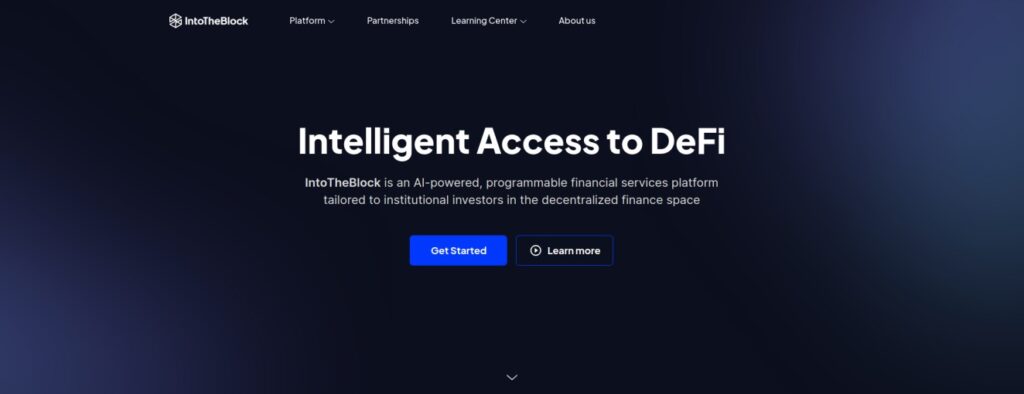
IntoTheBlock is a specialized onchain analysis tool that focuses on transaction data and wallet analysis techniques. It provides crypto investors with valuable information to navigate the complex blockchain world.
Key Features and Functionalities of IntoTheBlock
- Transaction Data Analysis: intotheblock is excellent at breaking down transaction data and giving detailed information about transaction volumes, values, and frequencies.
- Wallet Analysis Techniques: The platform offers comprehensive wallet analysis, allowing users to monitor wallet address behaviors and identify significant movements.
- Predictive Models: Using machine learning models, intotheblock makes predictions about price trends and market changes based on historical and real-time data.
- Market Indicators: The tool provides a range of indicators such as In/Out of the Money (IOM), which helps understand how an asset is performing compared to current prices.
Analyzing Hash Rate Dynamics
intotheblock also has features for analyzing hash rate dynamics, which is crucial in assessing the health and security of blockchain networks. By keeping track of changes in hash rate, users can get insights into miner behavior, network security levels, and potential impacts on cryptocurrency prices.
Pros and Cons of IntoTheBlock for Onchain Analysis
Pros
- Comprehensive Data Coverage: Offers extensive coverage of transaction data and wallet activities.
- User-Friendly Interface: Easy to use with intuitive dashboards and clear visualizations.
- Advanced Predictive Models: Uses machine learning for accurate market predictions.
Cons
- Subscription Costs: Premium features come with a higher price that might not be affordable for all users.
- Learning Curve: Some advanced features may take time to learn for new users.
IntoTheBlock's strong analytical abilities make it a must-have tool for serious crypto investors who want practical insights from transaction data and wallet activities.
8. CoinMetrics
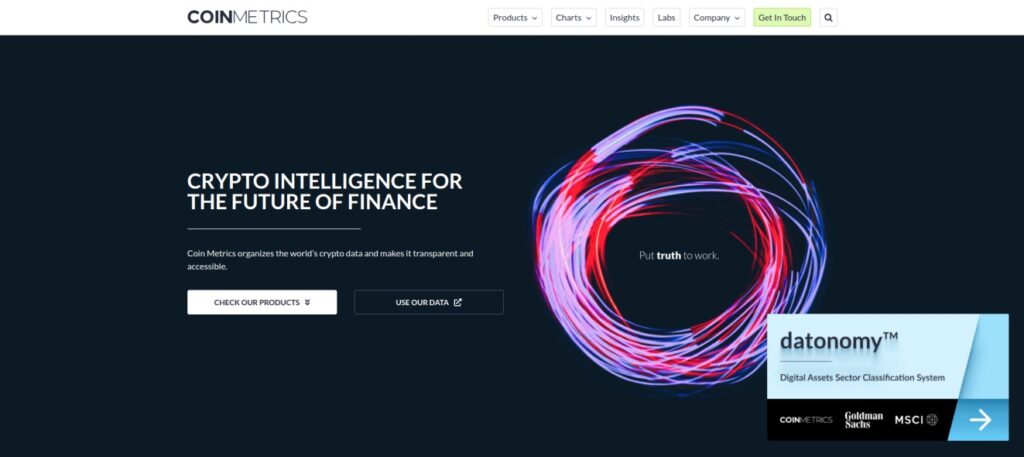
CoinMetrics is a well-known onchain analysis platform that stands out for its focus on the UTXO realized cap. This metric provides valuable insights into the total value of all unspent transaction outputs (UTXOs) at the time they were created. By understanding this, traders and investors can determine the realized market cap, which gives a clearer understanding of the actual economic activity happening on the blockchain.
Key Features and Functionalities
CoinMetrics offers a wide range of features that are designed to improve onchain analysis:
- Comprehensive Data Metrics: CoinMetrics provides over 100 different metrics, ranging from transaction volumes to miner revenues, ensuring users have access to diverse data points.
- Network Data Visualization: Users can easily see network data through charts and graphs that are easy to understand, making complex information simpler to grasp.
- API Access: For developers and advanced users, CoinMetrics offers a powerful API access that allows them to seamlessly integrate its data into their own custom applications or trading algorithms.
Analyzing the Ethereum Blockchain
When it comes to analyzing the Ethereum blockchain, CoinMetrics excels with tools specifically designed for this purpose:
- ERC-20 Token Metrics: Detailed metrics for various ERC-20 tokens allow for a deep dive into token-specific activities and trends.
- Smart Contract Analysis: Insights into smart contract interactions provide valuable information about dApp usage and DeFi activities.
- Gas Fee Tracking: Users can monitor gas fees, helping them understand network congestion and optimize transaction timing.
Pros and Cons of CoinMetrics
Pros:
- Extensive Data Coverage: With a wide array of metrics, CoinMetrics covers almost every aspect of blockchain data.
- User-Friendly Interface: The platform's interface is designed to be intuitive, making it accessible even to those new to onchain analysis.
- Reliable Data Quality: CoinMetrics is known for its high-quality, accurate data which is critical for making informed decisions.
Cons:
- Costly for Premium Features: Some advanced features and detailed metrics come at a premium price, potentially limiting access for smaller traders.
- Steeper Learning Curve for Beginners: Despite its user-friendly interface, the sheer amount of data can be overwhelming for beginners.
CoinMetrics' comprehensive suite of tools makes it an invaluable resource for those looking to leverage UTXO realized cap and other metrics in their crypto investment strategies.
9. Whalemap

Whalemap is a unique onchain analysis tool designed specifically for monitoring whale and institutional holdings, as well as token movements and holders. This platform offers valuable insights into how large-scale investors, known as “whales,” impact the crypto market.
Key Features and Functionalities of Whalemap
Here are some of the key features and functionalities offered by Whalemap:
Whale Wallet Tracking
- Identify and monitor wallets held by large holders to understand their buying and selling patterns.
Token Movements Analysis
- Visualize significant transfers of tokens to gain insights into market liquidity and potential price effects.
Heatmaps
- Utilizes innovative heatmaps to display areas where there is significant accumulation or distribution of tokens. This can help identify potential support and resistance levels.
Real-Time Alerts
- Receive instant notifications about substantial whale activities that could indicate major market movements.
Understanding the Impact of Whale Activity
Whale activity can have a significant influence on market sentiment and price movements. Here's how different types of whale activity can impact the market:
- Accumulation: When whales are accumulating a particular cryptocurrency, it may indicate bullish sentiments and lead to potential price rallies.
- Distribution: On the other hand, when whales are distributing or selling off their holdings, it could suggest bearish trends in the market.
By analyzing this data through Whalemap, traders can anticipate market shifts with greater accuracy.
Pros and Cons of Whalemap for Onchain Analysis
Pros:
- Focused Insights: Whalemap specializes in providing detailed information about whale activity, which is not commonly available on other platforms.
- Real-Time Data: Immediate access to whale movements helps traders make timely decisions.
- User-Friendly Interface: The intuitive design of Whalemap makes it easy to navigate, even for non-technical users.
Cons:
- Scope Limitation: Whalemap primarily focuses on whale activities and may not provide comprehensive coverage of other important onchain data.
- Subscription Costs: Some advanced features of Whalemap require a premium subscription, which could be expensive for smaller traders.
By using the powerful analytical tools offered by Whalemap, crypto traders can gain a strategic advantage in understanding and responding to the actions of major market players.
Limitations of Onchain Analysis
Onchain analysis is a powerful tool, but it has inherent limitations that can affect its accuracy and effectiveness. Here are some key limitations to keep in mind:
1. Inability to Capture Offchain Activities
One major limitation is the inability to capture offchain activities. Many significant transactions and interactions occur outside the blockchain, such as over-the-counter (OTC) trades and private deals. These activities remain invisible to onchain analytics tools, creating blind spots in the data.
2. Difficulty in Attributing Wallet Addresses
Another challenge lies in attributing wallet addresses to individuals or entities. The pseudonymous nature of blockchain transactions makes it difficult to precisely identify who controls specific wallets. This limitation can lead to misinterpretations, especially when trying to analyze market sentiment or track the behavior of specific investors.
3. The Potential Role of AI and Machine Learning
The potential role of AI and machine learning in enhancing onchain analysis cannot be overstated. By leveraging advanced algorithms, AI can identify patterns and anomalies that may not be immediately apparent through traditional analysis methods. Machine learning models can continuously improve their accuracy by learning from new data, thus providing more reliable insights over time.
4. Importance of Data Quality
Ensuring data quality is crucial for accurate onchain analysis. Poor-quality data—whether due to incomplete records, outdated information, or erroneous entries—can lead to flawed conclusions. High-quality data sets are essential for generating meaningful insights that traders and investors can rely on.
5. Need for Accurate Interpretation
Accurate interpretation of data is equally important. Even with high-quality data, the insights derived depend heavily on how well analysts understand the context and nuances of blockchain activities. Misinterpretation can result in misguided strategies and investment decisions.
Understanding these limitations helps users make more informed choices about how to incorporate onchain analysis into their broader strategy.
Chainalysis: A Comprehensive Blockchain Data Platform
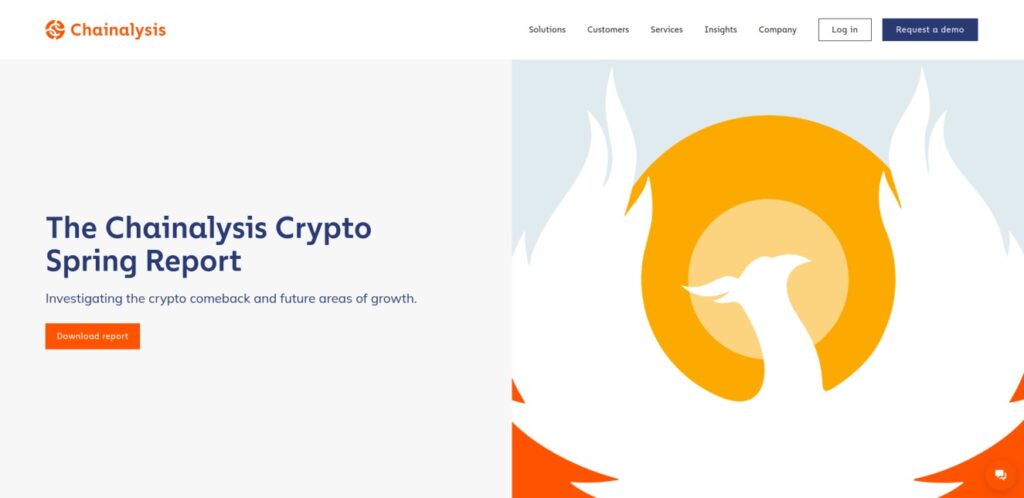
Chainalysis is a leading blockchain data platform that offers more than just onchain analysis. It is a powerful tool that is essential for various players in the crypto world, especially government agencies and financial institutions.
Support for Law Enforcement
Chainalysis plays a crucial role in detecting crypto crimes. It helps law enforcement agencies find, stop, and prevent illegal activities involving cryptocurrencies by using advanced data investigations. The platform has the following features:
- Tracking illicit transactions: Identifying suspicious patterns and tracing the flow of funds.
- Forensic analysis: Providing detailed insights into complex crypto-related crimes.
- Collaborative tools: Enhancing inter-agency cooperation through shared data and resources.
Compliance and Risk Assessment for Financial Institutions
In the world of digital assets, it is crucial for financial institutions to comply with regulations. Chainalysis offers comprehensive solutions to help them meet regulatory requirements and manage risks associated with crypto transactions. Key features include:
- Risk assessment tools: Evaluating the risk level of transactions and wallet addresses.
- Real-time monitoring: Continuously tracking transactions to identify potential compliance issues.
- Regulatory reporting: Simplifying the process of meeting regulatory obligations with precise and accurate data.
By offering these important services, Chainalysis enables financial institutions to confidently participate in cryptocurrency activities, explore new sources of income, and maintain strong security measures and customer trust.
Chainalysis shows how blockchain data platforms can go beyond traditional onchain analysis to provide comprehensive solutions that meet both law enforcement needs and financial industry standards. This approach highlights its importance in shaping a secure and compliant crypto ecosystem.
Conclusion
Using onchain analysis tools can completely change the way you approach cryptocurrency trading and investment. The platforms mentioned in this article offer a wide range of features that are specifically designed to give you a deep understanding of market trends, ownership patterns, whale activity, and much more.
To make the most of these onchain analysis tools, here are some suggestions:
- Use Glassnode to get a comprehensive view of market sentiment and ownership tracking.
- Check out Nansen for detailed analytics on Ethereum-based DeFi and NFTs.
- Take advantage of Messari to access various metrics on Solana and stablecoins.
- Dive into Dune to get insights on transaction volume and supply distribution.
- Analyze realized profits and stock-to-flow ratios using CryptoQuant.
- Keep an eye on HODL status and MVRV ratios with Santiment.
- Explore transaction data and wallet analysis with intotheblock.
- Look into UTXO realized cap using CoinMetrics.
- Understand whale activity through Whalemap.
By incorporating these tools into your trading strategy, you'll have access to invaluable information about the blockchain. This will help you make better-informed decisions when it comes to trading cryptocurrencies.
So go ahead, embrace the power of onchain analysis, and take your understanding of the crypto market to new heights!
FAQs (Frequently Asked Questions)
What is the significance of onchain analysis in the crypto industry?
Onchain analysis plays a crucial role in providing valuable insights and data for crypto investors and traders to make informed decisions. It enables the examination of blockchain data to understand market trends, ownership patterns, transaction volumes, and other critical metrics.
What are the key features and functionalities of Glassnode as an onchain analysis tool?
Glassnode offers market sentiment analysis, ownership tracking, and price action tools. It provides comprehensive onchain data for users to gain insights into the crypto market and make informed decisions.
How does Nansen specialize in onchain analytics?
Nansen focuses on providing comprehensive onchain analytics with a specific emphasis on the Ethereum blockchain. It offers tools for examining DeFi capital markets, NFT analytics, and other Ethereum-related metrics.
What capabilities does CryptoQuant offer as an onchain analysis platform?
CryptoQuant specializes in realized profits and losses data, as well as the significance of stock-to-flow ratio in onchain analysis. It provides valuable insights for investors and traders to understand market dynamics.
What are some limitations of onchain analysis methodologies?
Onchain analysis methodologies face limitations such as the inability to capture offchain activities and challenges in attributing wallet addresses to individuals. Ensuring data quality and exploring potential AI/machine learning enhancements are important considerations for effective onchain analysis.
How does Chainalysis go beyond traditional onchain analysis?
Chainalysis serves as a comprehensive blockchain data platform that extends beyond traditional onchain analysis. It supports law enforcement agencies in detecting and deterring crypto-related crimes, while also providing compliance solutions and risk assessment tools for financial institutions dealing with digital assets.



